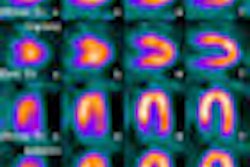The Australian PET Data Collection Project is amassing more evidence that shows that PET positively changes management plans for cancer patients.
Led by Dr. Andrew Scott, director of the Centre for PET at Austin Hospital in Melbourne, the newest research shows that PET provides important prognostic information in a large proportion of patients with untreated head and neck cancer, and detects additional sites of disease.
The prospective study, published in the October issue of the Journal of Nuclear Medicine (October 2008, Vol. 49:10, pp. 1593-1599), was conducted at three Australian PET centers between December 17, 2003, and June 3, 2005. The criteria for enrollment included patients who previously had untreated carcinoma of the nasal cavity, nasopharynx, oral cavity, oropharynx, hypopharynx, or larynx, or had metastatic disease involving cervical lymph nodes from an unknown primary. Patients underwent examination under anesthesia and biopsy to confirm their diagnosis of cancer.
Contrast-enhanced CT of the neck was required within six weeks of the PET scan. Patients fasted for a minimum of six hours before the PET study and received a dose of 120-440 MBq FDG intravenously. After a minimum uptake period of 45 minutes, researchers acquired PET data from the skull vertex to at least the lower abdomen.
Treatment plans
Before receiving the results of the PET scans, researchers asked referring clinicians to document their management plan for the patient, as if PET findings were not available, but with access to all other clinical and conventional imaging results. The management plan provided information on options such as surgery, radiation therapy, chemotherapy, or a combination of each.
Once clinicians had the chance to view results from PET scans, they were asked to update their cancer treatment strategies in lieu of the additional information, detailing to what degree, if any, the original management plan was changed.
Researchers analyzed 71 patients with a median age of 56 years, ranging from 35 years to 86 years. Among the 49 men and 22 women, a total of 156 lesions were detected in the pre-PET evaluation.
Lesion detection
Forty patients were evaluated with standalone PET, while 31 patients underwent PET/CT scans. PET detected a total of 171 lesions, of which 160 lesions were consistent with malignancy and 11 lesions were equivocal. PET also detected 43 additional lesions in 28 patients (39%). Nine of those lesions were classified as primary lesions, 27 were regional lymph nodes, and seven lesions were distant metastases.
Primary lesions were not detected in 15 patients during pre-PET evaluation. Seven of the primary lesions detected only by PET relate to seven of the 15 patients (47%). The other two additional primary lesions detected by PET were interpreted as second primary lesions in two patients. In both cases, the first primary lesion was detected prior to PET imaging.
In 15 patients, 28 lesions were detected on the pre-PET evaluation, but not detected on the follow-up PET scan. Of those 28 lesions, five were classified as primary lesions, 22 were considered regional lymph nodes, and one was a possible distant metastatic lesion.
Altered plans
After clinicians reviewed PET images, management plans were altered on the basis of the PET results in 24 patients (34%), with a 95% confidence interval. PET detected additional lesions in 19 of those 24 patients. In the remaining five patients, radiation volume was changed in three cases; in the remaining two cases, the radiation dose was changed and chemotherapy halted.
The study "demonstrates that PET has a significant impact on patient management and predicts outcomes in patients with previously untreated head and neck cancer," the authors wrote. "PET scans resulted in a clear management change in 24 of the 71 patients (34%) ... A high or medium management impact was also observed in a third of patients."
Primary tumors
PET did not identify a small number of primary tumors, most likely because of prior removal at biopsy or because the lesion was below the limits of resolution of any imaging modality. In nine patients, previously unknown primary lesions were identified; two patients had a second primary detected, and seven of the 15 patients (46.7%) with unknown primaries and metastatic lymph node disease had primary tumors identified.
The authors cited one limitation of the study. "Different subgroups of head and neck cancer (base of tongue, oropharynx, etc.) are managed differently," they wrote, "and one limitation of the study was that the patient numbers in each of the subgroups were small, preventing individual analyses."
They also noted that their results for head and neck cancer were comparable to data from the U.S. National Oncologic PET Registry (NOPR), which found that treatment plans were changed in 36% of cancer cases, particularly for prostate, pancreatic, and ovarian cancer patients, after clinicians reviewed PET images.
By Wayne Forrest
AuntMinnie.com staff writer
October 8, 2008
Related Reading
NOPR: PET changes care of more than a third of cancer patients, October 6, 2008
PET changes care of colorectal cancer patients, study shows, September 2, 2008
FDG-PET changes treatment plans for glioma patients, June 26, 2008
FDG-PET is effective for diagnosing spinal tumors, April 9, 2008
PET changes oncology management, study shows, July 19, 2007
Copyright © 2008 AuntMinnie.com




















